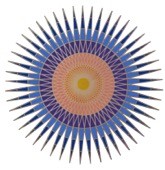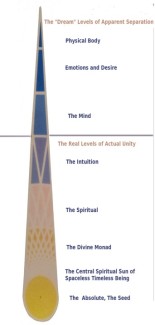The Journey to Universal Brotherhood
The theme of our recent Convention in Napier, The Way Forward for Humanity: Achieving Universal Brotherhood, engenders ongoing dialogue. The theme comes from the Society’s First Object: To form a nucleus of the Universal Brotherhood of Humanity, without distinction of race, creed, sex, caste or colour.
What does this term ‘Universal Brotherhood’ really mean?
Universal Brotherhood, or Brotherhood and Sisterhood as usually said today, is a term that refers to a state of awareness that unites us. The implication is that our current state of awareness does not recognise this unity consciousness. Our awareness is asleep. It is so focused on the outside world, the world we perceive through our mind and senses, that we have lost the awareness of the inner unity consciousness that the shamans, the sages, mention and which the mahatmas call the real world – the world where we know who we really are. This is hinted at in world mythologies, by the sources of the world religions and by the ancient texts. Furthermore the First Object of the Theosophical Society has as its Vision: to form a ‘nucleus’ of a group who are working from this inner reality rather than from their personalities.
This is our challenge as human beings: to awaken our awareness, to step beyond into the knowledge that we live in a unity, to experience it fully and live it. The experience changes one forever.

The diagram of the star gives us a pictorial view of this unity. In the diagram the rays coming out of the centre of the star all look separate, they represent our personality or human incarnation. Each ray appears to be separate from the others as you look at the outer arms, and so it is as we see each other as separate beings with no connection in the world in which we live, the world of apparent separateness. However, as you go towards the centre of the star the individual arms, which were separated, now join together and are united. The further into the centre we travel the stronger the unity consciousness is.
This idea is also indicated in the TS emblem by the two triangles. The one pointing downwards represents our personality like the separate points in the star diagram and the triangle pointing upwards represents that part in the star where there is connectedness, representing our unity consciousness or our spiritual soul where the unity is a reality.
If we take a single arm from the star we can see the different aspects more clearly. The illusionary ‘Dream Levels of Apparent Separation’, at the top, comprise our physical body, emotion and the mind (often called the lower or concrete mind in theosophy). This is the part of our nature that gives the appearance of separation from each other. We generally feel and think differently from each other. This is also the world of the senses, where we focus all our attention, through sight, hearing, taste, smell and thought and where they are all united to create the illusionary reality we call life.
If we remove our awareness from our senses, then where do we find ourselves? At first we might find ourselves focused in thought, in our mind. However, with practice we are able to move our awareness deeper within our nature to the more real Self. The unity consciousness, or the higher triad as it is often called, is also the higher mind, the buddhi or intuition and the spiritual soul. In the diagram it is represented as intuition, the spiritual, the divine monad and the absolute; all deeper levels of unity consciousness.
Theosophy teaches us that these inner levels are our ‘truer nature’. As we explore ourselves and study the great texts of the world we will find this as a common thread almost everywhere. The world myths also point to this through the quest of the hero, who is generally trying to find an object which symbolises one’s true nature or something very special. These quests often go on for many years, if not lifetimes until the hero learns that the answer is not outside himself in an object but rather within his own being. The real treasure is within us. We each are the hero of the story trying to find our sword or Holy Grail, to eventually realise that we already have it if we would only look into our hearts.
The Journey
The road to Unity awareness is not something that happens simply because we know about it. We might have the knowledge and that is a good start. The next step is to experience this, to awaken into the unity and to live within it. It is a journey we take. Some thoughts to consider in doing this are:
While all our attention or awareness is focused through only the senses we are distracted from what is real.
We must turn our focus away from the senses, to connect with our spiritual reality or awareness.
This requires a shift in our ideas of what is real and unreal.
One of the methods to achieve this is through the process of meditation. We set aside some time each day to withdraw from the outer world of the senses and the mind and to journey within. There are many types of meditation taught today, however the useful ones for this purpose are where we focus our attention – our awareness – towards a single point. This might be an object, an abstract thought or phrase, or mantra, and we explore that object with our full awareness, keeping our attention focused and being aware of when it wanders off and gently bringing it back to the point of focus. The point is to remove the focus from the world of the senses and turn inwards, so not to allow sense objects such as music, smells, or stray thoughts for example, to distract. This is important.
One of the most useful expositions on meditation is the Yoga Sutras of Patanjali. These are a series of aphorisms (seed thoughts). There are many translations of the Yoga Sutras with commentaries. One particularly good one is The Science of Yoga: The Yoga Sutras of Patanjali by I.K. Taimni, which will be available in most Theosophical libraries.
Conditioning
A part of the inner journey is to clear our programming, our conditioning; those things that block or filter our perception of reality. Our awareness is focused through our psychological nature, through our emotions and thoughts. These emotions and thoughts develop filters over our lifetime(s) which distort our view of reality. These filters, when they are negative, can have a huge effect on our perceptions. For example, while I was at secondary school my music teacher told me that I could not sing. This had an effect on the rest of my life as I carried around the belief that I could not sing and therefore did not sing for many years, at least until I realised I was conditioned and overcame the conditioning.
We all carry around with us these conditionings. Many of us have had strong emotional experiences which have marked our lives and prevent us from doing certain things as we do not want to repeat these experiences or bring up the pain again. These negative experiences affect how we act and cloud our perception of things and until they are removed or processed, they can prevent us from being whole. At some point we need to clear these or we may eventually become ill due to the psychological stress. To become fully human and integrate the higher and lower natures of ourselves we must clear out or purify the lower nature, to remove these filters of conditionings.
Our conditioning comes from:
Our experiences early in life
Our families
Our culture
Our education
Past lives, through tendencies and karma.
Values
Another step on the journey to unity is to align our values. We live in a world where there are different value systems we have to contend with. For example your work values and personal values might not be the same. In fact they could even clash. Do they?
What are your personal values, your cultural values or social values? Do they align with Universal Values? These are the values that we see in many of the religions of the world, such as: non-violence (ahimsa), being truthful, tolerance of different viewpoints, love, selflessness, contentment, kindness and compassion. There are many more.
The challenge for us is to align all our value systems, so that our personal values attune with our universal values. If they do not line up then there is a tension within us that will eventually manifest in disease.
Non-violence is a common one that can cause a challenge. The Sanskrit word is Ahimsa and is common to almost all religious teachings. Generally it means: cause no harm. When taken seriously this applies physically, emotionally and mentally. Gossip is one of the most destructive things we can be involved in and is quite a violent way of being. The study of non-violence is quite an interesting one, as it applies to wars and the question of standing up against many oppressive and unjust practices. This requires some assertive behaviour. There is also right-action which needs to be taken into account alongside all of this.
Finally, the journey to Universal Brotherhood is about realising and living the Unity we are all a part of and then living in the world with this awareness constantly in mind, always acting from universal values with consideration for everyone. It is difficult to achieve this Brotherhood mainly because we are so focused in the personality and the world of the senses. We have forgotten who we really are and no longer know how to find ourselves as we struggle to find what is real in the world of illusions that we have created with our minds.
Universal Brotherhood is found through consistent practice. It requires effort and only we are able to make that jump from the unreal to the real. No one else can do this for us.
by John Vorstermans
--- Published in the TheoSophia issue, March 2015
